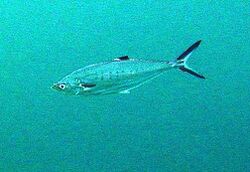Biology:Doublespotted queenfish
| Doublespotted queenfish | |
|---|---|

| |
| Scientific classification | |
| Domain: | Eukaryota |
| Kingdom: | Animalia |
| Phylum: | Chordata |
| Class: | Actinopterygii |
| Order: | Carangiformes |
| Family: | Carangidae |
| Genus: | Scomberoides |
| Species: | S. lysan
|
| Binomial name | |
| Scomberoides lysan (Forsskål, 1775)
| |
| Synonyms[2] | |
| |
The doublespotted queenfish (Scomberoides lysan) is a tropical game fish in family Carangidae (jacks). It is associated with reefs and ranges widely throughout the Indian and Pacific Oceans. Other common names for this fish are giant dart, large-mouthed leatherskin, leatherskin, queenfish, skinny fish, skinnyfish, St. Peter's leatherskin, white fish or whitefish.[3] イケカツオ(生鰹, Ikekatsuo)is in Japanese.
Doublespotted queenfish are known to reach up to 110 cm total length and mass up to 11.0 kg (24.3 lb). They are primarily silver in color, with dark coloration on the dorsal and caudal fins and a row of dark spots on either side of the lateral line. Scales needle-like and embedded in tough skin; breast scales sharply lanceolate and embedded on middle of body below lateral line but lack the scutes of some other jacks.[3]
This species ranges eastward from the Red Sea and eastern Africa to Hawaii, the Marquesas, and the Tuamotu Islands. It is found as far north as southern Japan and south to New South Wales and Rapa Iti. It occupies relatively clear waters from the surface to about 100 m (330 ft). Juveniles inhabit shallow water near the shore, including brackish areas. Adults are associated with reefs. They are primarily solitary.[1]
Juveniles feed on the scales of schooling fish. Like most jacks, adults prey on fish and crustaceans.[2] This species is venomous with the venom found on the spines of the dorsal and anal fins.[4]
Relationship with humans
Doublespotted queenfish are pursued as game fish and are sometimes used as bait as well. The IGFA all tackle world record for the species stands at 3.29 kg (7 lb 4 oz) caught off of Benguerra Island, Mozambique in 2008.[5]
References
- ↑ 1.0 1.1 Smith-Vaniz, W.F.; Williams, I. (2016). "Scomberoides lysan". IUCN Red List of Threatened Species 2016: e.T20434766A115381420. doi:10.2305/IUCN.UK.2016-3.RLTS.T20434766A46664119.en. https://www.iucnredlist.org/species/20434766/115381420.{{cite iucn}}: error: |doi= / |page= mismatch (help)
- ↑ 2.0 2.1 Froese, Rainer and Pauly, Daniel, eds. (2019). "Scomberoides lysan" in FishBase. August 2019 version.
- ↑ 3.0 3.1 Bray, D.J. (2017). "Scomberoides lysan". Fishes of Australia. Museums Victoria. http://fishesofaustralia.net.au/home/species/4282.
- ↑ Bruce W. Halstead; Dana D. Danielson; Wayne J. Baldwin; Paul C. Engen (1972). "Morphology of the venom apparatus of the leatherback fish Scomberoides sanctipetri (Cuvier)". Toxicon 10 (3): 249–250. doi:10.1016/0041-0101(72)90010-4. PMID 5072090. Abstract
- ↑ "Queenfish, doublespotted". IGFA. https://igfa.org/igfa-world-records-search/?search_type=CommonName&search_term_1=Queenfish,%20doublespotted.
Wikidata ☰ Q1816318 entry
 |



